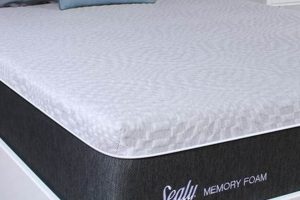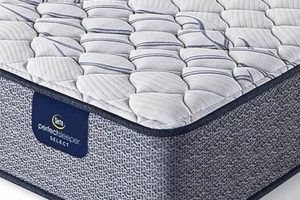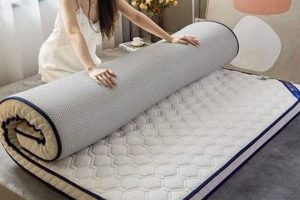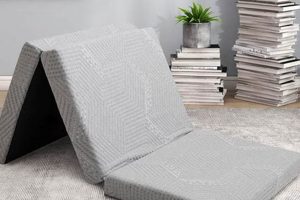A bed accessory designed to enhance comfort and support is typically constructed from viscoelastic foam. Its purpose is to provide an additional layer on top of a standard mattress, conforming to the body’s contours and potentially alleviating pressure points. The question of whether this bedding component is amenable to standard cleaning practices is a common concern for owners.
Maintaining a hygienic sleep environment is paramount for both physical health and restful sleep. Regular cleaning of bedding components contributes to the removal of allergens, dust mites, and body oils. Understanding the appropriate cleaning methods for this type of topper ensures its longevity and continued effectiveness in providing comfort.
The following sections will detail the recommended procedures for cleaning and maintaining such a topper, addressing the feasibility of machine washing and alternative cleaning methods to preserve its integrity.
Memory Foam Mattress Topper Cleaning Recommendations
The following are recommendations for preserving the cleanliness and longevity of memory foam mattress toppers. Adherence to these guidelines will contribute to a more hygienic sleep environment and potentially extend the lifespan of the product.
Tip 1: Vacuum Regularly: Employ a handheld vacuum or upholstery attachment to remove surface debris, dust, and allergens. Consistent vacuuming, ideally every one to two weeks, minimizes the accumulation of particles that can compromise the topper’s hygiene.
Tip 2: Spot Clean Promptly: Address spills and stains immediately. Use a clean cloth dampened with a mild detergent solution. Blot the affected area gently, working from the outside in, to prevent spreading. Avoid saturating the foam.
Tip 3: Air Out Periodically: Remove the topper from the mattress and allow it to air out in a well-ventilated area. This process helps to dissipate moisture and odors. Direct sunlight should be avoided to prevent material degradation.
Tip 4: Utilize a Mattress Protector: A waterproof mattress protector provides a barrier against spills, stains, and allergens. This preventative measure significantly reduces the need for frequent or intensive cleaning.
Tip 5: Consider Professional Cleaning: For deep cleaning or persistent stains, professional upholstery cleaning services may be beneficial. Ensure the cleaning method is compatible with memory foam to avoid damage.
Tip 6: Avoid Harsh Chemicals: Refrain from using harsh chemicals, bleach, or abrasive cleaners. These substances can degrade the foam’s structure and compromise its comfort properties.
Tip 7: Check the Manufacturer’s Instructions: Consult the product’s care label or manufacturer’s website for specific cleaning recommendations and warnings. Following these guidelines ensures proper maintenance and prevents voiding any warranties.
Following these recommendations promotes a clean and healthy sleep surface, extending the life of the memory foam mattress topper and maximizing its comfort benefits.
The subsequent sections will address frequently asked questions regarding memory foam mattress topper care and maintenance.
1. Material Degradation
Material degradation, in the context of memory foam mattress toppers, refers to the deterioration of the foam’s physical properties and structural integrity. Introducing water through washing processes accelerates this degradation, impacting the topper’s comfort and lifespan.
- Cell Structure Breakdown
Memory foam consists of open cells that allow air circulation and provide its conforming properties. Washing subjects these cells to hydrostatic pressure, causing them to rupture or collapse. This results in a loss of the foam’s characteristic responsiveness and support.
- Chemical Decomposition
The chemical compounds that give memory foam its viscoelastic properties are susceptible to hydrolysis, a chemical reaction with water. Washing accelerates this process, breaking down the foam’s polymer chains and leading to a loss of elasticity and density.
- Increased Fragility
Once the foam’s structure and chemical composition are compromised, it becomes more brittle and prone to tearing. Regular washing cycles exacerbate this fragility, reducing the topper’s ability to withstand normal use and increasing the likelihood of damage during handling.
- Loss of Support
The primary function of a memory foam mattress topper is to provide enhanced support and pressure relief. Material degradation directly undermines this function, as the foam loses its ability to evenly distribute weight and conform to the body’s contours, leading to discomfort and potentially disrupting sleep quality.
Considering these facets, washing a memory foam mattress topper presents a considerable risk of material degradation. This can compromise its structure, reduce its comfort, and shorten its lifespan. Alternative cleaning methods, such as spot cleaning and professional cleaning, are generally recommended to mitigate these risks.
2. Water Retention
Water retention is a critical factor in determining the feasibility of washing memory foam mattress toppers. The material’s inherent properties make it prone to absorbing and retaining significant amounts of water, leading to various complications.
- Density and Porosity
Memory foam possesses a dense, open-cell structure, allowing water to penetrate deep within the material. This high porosity facilitates water absorption, and the density hinders its subsequent release. Consequently, a soaked topper becomes exceedingly heavy and difficult to manage.
- Prolonged Drying Times
Due to its structure, memory foam requires extended periods to dry completely. Even after surface water is removed, moisture remains trapped within the interior layers. This prolonged dampness creates an environment conducive to mold and mildew growth, compromising hygiene and potentially damaging the foam’s structure.
- Structural Integrity Compromise
The weight of water-saturated memory foam can distort its shape and compromise its structural integrity. The foam’s cells may stretch or break under the added weight, leading to uneven support and decreased comfort. This deformation can be irreversible, permanently altering the topper’s original form.
- Cleaning Agent Residue
Washing memory foam introduces the risk of detergent or cleaning agent residue remaining trapped within the material. Rinsing becomes challenging due to the foam’s water retention, and residual cleaning agents can cause skin irritation or degrade the foam over time.
These facets highlight the significant challenges posed by water retention when considering the washability of memory foam mattress toppers. The material’s properties make it susceptible to damage, mold growth, and structural compromise, underscoring the need for alternative cleaning methods.
3. Structural Damage
Structural damage represents a significant consequence associated with washing memory foam mattress toppers. The material’s composition and construction render it susceptible to irreversible harm when subjected to the mechanical stresses of a washing machine or excessive water exposure.
- Tearing and Ripping
The agitation within a washing machine can exert considerable force on the foam’s delicate structure. This force can lead to tearing or ripping, particularly along edges or areas weakened by prior use. Once tears occur, the topper’s structural integrity is compromised, leading to uneven support and a diminished lifespan. For example, a topper forced into a machine too small for it might experience significant tearing. This undermines the primary purpose of the topper.
- Compression and Deformation
The weight of waterlogged memory foam, combined with the pressure of the washing machine’s spin cycle, can cause compression and permanent deformation. The foam’s cells may collapse under the excessive pressure, resulting in flattened areas that no longer provide adequate support. An overloaded washing machine is more likely to inflict this type of damage. Such deformation detracts from the user’s comfort and nullifies the topper’s ergonomic benefits.
- Loss of Density and Resilience
The repeated stress of washing can diminish the foam’s density and resilience. The foam’s internal structure breaks down, reducing its ability to spring back to its original shape after compression. This loss of resilience translates to a less supportive and less comfortable sleeping surface. Over time, the topper may lose its ability to contour to the body effectively, negating its primary advantage.
- Delamination of Layers
Some memory foam mattress toppers consist of multiple layers of foam. Washing can cause these layers to separate or delaminate, further compromising the topper’s structural integrity. This separation creates uneven surfaces and inconsistent support, diminishing the overall quality and comfort of the topper. The adhesive used to bond the layers may weaken with repeated washing, accelerating the delamination process.
These facets underscore the inherent risks of structural damage associated with washing a memory foam mattress topper. The potential for tearing, compression, loss of density, and delamination collectively contribute to a diminished lifespan and reduced comfort. Alternative cleaning methods, such as spot cleaning and professional upholstery cleaning, are often recommended to mitigate these risks and preserve the topper’s structural integrity.
4. Spot Cleaning
Given the limitations associated with fully washing memory foam mattress toppers, spot cleaning emerges as a critical maintenance technique. It addresses localized stains and spills without subjecting the entire topper to the risks of water saturation and structural damage inherent in conventional washing methods. The efficacy of spot cleaning directly impacts the necessity of more aggressive cleaning measures; prompt and effective spot cleaning can prevent stains from setting and permeating deeper into the foam, thus reducing the need for more extensive cleaning interventions. For instance, immediately blotting a coffee spill with a clean, dry cloth, followed by gentle application of a mild detergent solution to the affected area, can often remove the stain entirely, precluding the need for more comprehensive cleaning efforts.
The selection of appropriate cleaning agents is paramount in spot cleaning. Harsh chemicals, such as bleach or ammonia, can degrade the memory foam and discolor the fabric. Mild detergents, diluted according to the manufacturer’s instructions, are preferred. The application method also requires careful consideration; excessive rubbing or saturation can spread the stain or damage the foam. A gentle blotting motion, working from the outside of the stain inward, minimizes the risk of further contamination. The residue from cleaning agents must also be carefully removed by gently blotting the area with a clean, damp cloth, before air drying the treated area. Properly executed spot cleaning preserves the hygiene and aesthetic appeal of the topper without compromising its integrity.
In summary, spot cleaning constitutes a pivotal strategy in the care of memory foam mattress toppers. Its targeted approach mitigates the risks associated with full submersion cleaning, effectively addressing localized blemishes while preserving the topper’s structural integrity and extending its lifespan. While spot cleaning is effective for many stains and spills, it is not a panacea, and severe or widespread soiling may necessitate professional cleaning services. However, as a preventative measure and a first line of defense against everyday accidents, spot cleaning plays an indispensable role in maintaining a clean and comfortable sleep environment.
5. Professional Cleaning
Given the inherent risks associated with conventional washing methods, professional cleaning presents a viable alternative for maintaining the hygiene and extending the lifespan of memory foam mattress toppers. These specialized services offer controlled and gentle approaches designed to minimize the potential for material degradation and structural damage.
- Specialized Equipment and Techniques
Professional cleaning services utilize equipment designed for delicate upholstery and foam materials. Low-moisture extraction methods minimize water absorption, reducing the risk of mold growth and structural weakening. For example, steam cleaning, when performed by a trained technician, can effectively sanitize the topper without saturating the foam. This contrasts sharply with the aggressive agitation and water volume of a standard washing machine.
- Appropriate Cleaning Agents
Professionals employ cleaning solutions specifically formulated for memory foam. These agents are pH-balanced and free from harsh chemicals that can degrade the foam’s structure. For instance, enzyme-based cleaners can effectively break down organic stains and odors without compromising the foam’s integrity. The careful selection and application of these agents are essential to preserving the topper’s quality and comfort.
- Expert Stain Removal
Professional cleaners possess the knowledge and skills to address a wide range of stains effectively. They can identify the stain’s composition and apply targeted treatments that minimize the risk of discoloration or damage. For example, a protein-based stain, such as blood, requires a different approach than an oil-based stain. This expertise ensures that the stain removal process is both effective and safe for the memory foam material.
- Drying and Sanitization
Professional cleaning services often include specialized drying and sanitization processes. Industrial-grade dehumidifiers and air movers facilitate rapid drying, preventing mold growth and ensuring that the topper is thoroughly sanitized. Some services also incorporate UV-C light treatment to kill bacteria and dust mites. These post-cleaning steps are critical for maintaining a hygienic sleep environment and preventing long-term damage to the topper.
Professional cleaning represents a balanced approach to addressing hygiene concerns related to memory foam mattress toppers. By utilizing specialized equipment, appropriate cleaning agents, and expert techniques, these services mitigate the risks associated with conventional washing methods while effectively removing stains, odors, and allergens. The result is a cleaner, more hygienic sleep surface that retains its structural integrity and extends its lifespan. While typically more costly than at-home cleaning efforts, the benefits of professional intervention are more likely to protect what can be a sizable financial investment and ensure optimal health in what should be a haven from harmful particulates.
Frequently Asked Questions
The following questions address common concerns regarding the cleaning and maintenance of memory foam mattress toppers. These answers are intended to provide clarity and guidance on best practices.
Question 1: Is machine washing a recommended method for cleaning a memory foam mattress topper?
Machine washing is generally discouraged due to the potential for material degradation, water retention, and structural damage. The agitation and water volume can compromise the foam’s integrity.
Question 2: What cleaning agents are suitable for spot cleaning a memory foam mattress topper?
Mild detergents diluted with water are recommended for spot cleaning. Harsh chemicals, bleach, and abrasive cleaners should be avoided, as they can damage the foam.
Question 3: How frequently should a memory foam mattress topper be cleaned?
Regular vacuuming every one to two weeks is advisable. Spot cleaning should be performed promptly to address spills and stains. Professional cleaning may be considered annually or as needed for deep cleaning.
Question 4: Can drying a memory foam mattress topper in a machine cause damage?
Machine drying is not recommended due to the high heat and tumbling action, which can cause the foam to shrink, warp, or break down. Air drying in a well-ventilated area is preferable.
Question 5: How can odors be removed from a memory foam mattress topper?
Airing the topper in a well-ventilated area, sprinkling baking soda on the surface and vacuuming after several hours, or using a fabric refresher can help eliminate odors.
Question 6: What preventative measures can be taken to minimize the need for frequent cleaning?
Utilizing a waterproof mattress protector is an effective preventative measure against spills, stains, and allergens. Regular vacuuming also reduces the accumulation of dust and debris.
Adhering to these guidelines contributes to the longevity and hygiene of a memory foam mattress topper, ensuring a comfortable and healthy sleep environment.
The subsequent section will provide a concluding summary of the key considerations discussed in this article.
Conclusion
The central inquiry of whether can you wash memory foam mattress topper has been thoroughly explored. The analysis underscores the inherent limitations of traditional washing methods when applied to this bedding component. The potential for material degradation, water retention, and structural damage significantly outweighs any perceived benefits of machine washing. Spot cleaning and professional cleaning services emerge as safer and more effective alternatives for maintaining hygiene and extending the product’s lifespan.
Responsible ownership necessitates adherence to recommended cleaning practices. Consideration of the material’s specific properties, coupled with diligent preventative measures, ensures a prolonged and hygienic sleep surface. Prudent care of memory foam mattress toppers safeguards the investment and promotes a healthier sleep environment. Ultimately, understanding the risks and rewards of various cleaning options is key to enjoying the benefits of these products.







